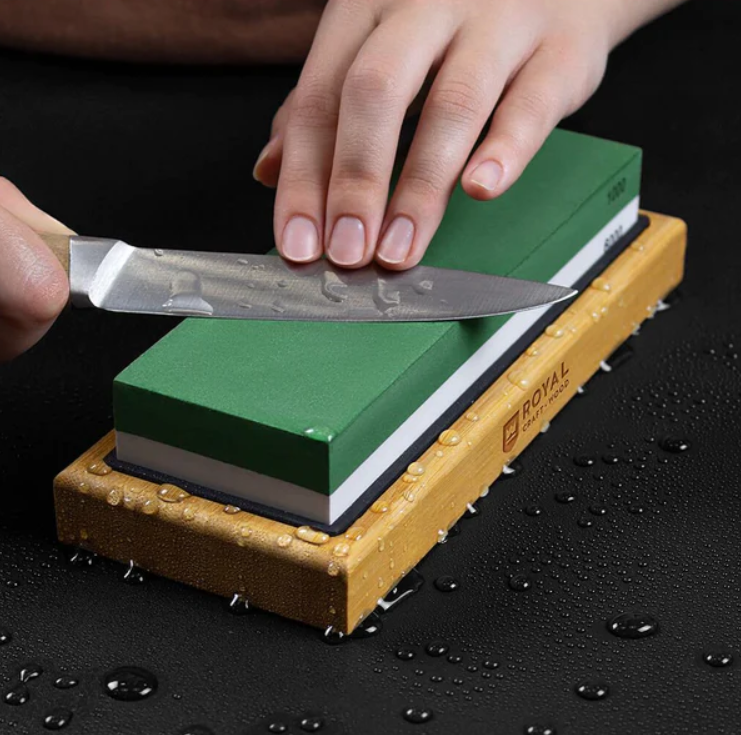
(Photo : Royal Craft Wood)
Sharpening kitchen knives is a vital part of keeping them in top condition. By regularly sharpening your kitchen knives, you will be able to make sure that they are always ready for use and that they stay sharper for longer. There are several methods for sharpening kitchen knives:
-
including using a honing steel (or rod),
-
a whetstone, or
-
an electric knife sharpener.
Let's try to understand all the advantages and disadvantages of each of the methods together with the specialists of Royal Craft Wood, a manufacturer of eco-friendly bamboo products for the kitchen and home.
How to sharpen kitchen knives with honing steel
Sharpening a kitchen knife with honing steel is an important practice for any cook or chef. Honing steel helps to keep knives straight and sharp longer than if honing was not done regularly. Although honing steel can help knives maintain their sharpness, it should not be used as a substitute for knife sharpening.
To use a honing steel, the user must first hold the handle of the steel firmly in one hand and take care to point the tip away from their body. With the other hand, grip the handle of the knife at a 20-degree angle and draw it down and across the length of the steel. Make sure to apply even pressure when drawing the blade against the length of the steel; this will help ensure a consistent sharpness across the entire edge of your blade. After each stroke, raise and reset your angle slightly before continuing down again. This motion should be repeated several times, always making sure to keep your hands in safe positions, until you have reached both sides of your blade's edge evenly.
When using a honing steel on your kitchen knives, you may notice small metal particles gathering on its surface which are caused by tiny burrs being removed from your knife's edge during use. To avoid these particles becoming lodged in food while cooking, make sure to clean off these bits between uses by wiping down with a clean cloth or damp towel before storing away. Additionally, it's best practice to align your blade's edge with that of the honing steel every time before usage; this helps ensure that you maintain an even sharpness across both sides of your blade for optimum performance in any task.
Honing kitchen knives regularly is an essential practice for any home cook or professional chef who wants reliable results from their blades at all times; when done correctly, honing can help keep blades sharper longer than if not done at all - but only when used in conjunction with proper knife sharpening techniques for optimal performance over time!
And now you know all the secrets of how to sharpen kitchen knives with a rod!
How to sharpen kitchen knives with a stone
Sharpening kitchen knives with a whetstone is an incredibly efficient, and cost-effective way to ensure your knives are kept in the best condition. Whetstones are easily available at any hardware store, or even online. The process of sharpening kitchen knives with a whetstone is fairly simple, but it does require some patience and precision.
The first step is to identify the type of whetstone you need for your particular knife blades. Generally, softer blades require a finer grit while harder blades can take on coarser grit stones. Once you have determined the right stone for the job, dampen it with some water or oil. You will then want to make sure that you put the blade on an angle that is appropriate for sharpening; typically between 15 and 20 degrees. You will then want to gradually move the blade across the surface of the stone until you see a burr appear along both sides of the edge of the knife blade.
Once you have established a consistent motion across both sides of your blade, move up in grit size until you reach a much finer one. This process helps create a smooth cutting edge as well as remove any metal burrs from previous grinding steps. As you move up to each higher grit size make sure that your strokes become lighter and more shallow than before - this will create an even smoother finish. Once you have reached your desired level of refinement, it is important that you switch between two or three different grades of honing stones at least once per session in order to avoid over-sharpening any parts of your blade's edge.
In addition to sharpening kitchen knives with whetstones, there are also other tools and techniques that can be used in order to maintain their pristine condition over time such as honing rods and ceramic sharpeners. Honing rods help realign bent edges back into shape while ceramic sharpeners work best for thinning out thickly worn edges which can often occur after extensive use over time. Each individual technique requires its own set of instructions which should be followed carefully in order for them to be effective. Regardless, when done correctly each method can help keep kitchen knives properly maintained so they remain reliable for years to come!
How to sharpen kitchen knives with a electric knife sharpener
Sharpening kitchen knives with an electric knife sharpener is an effective, convenient way to maintain the performance of your knives. Electric sharpeners are user-friendly, allowing you to quickly and easily get a professional-grade edge on your blades. The right sharpener can provide a great edge that will last for many uses.
Before beginning any sharpening process, it's important to make sure you have the right supplies and tools on hand. In addition to the electric sharpener, you'll want a set of whetstones (or diamond stones), a strop, and a honing rod. Make sure your knives are clean and free of debris before beginning the sharpening process.
To begin using the electric knife sharpener, plug it into a power source and turn it on. You'll be presented with one or more slots that correspond to different angles for edge grinding. Place the blade of your kitchen knife inside the appropriate slot for the desired angle-it's usually labeled on the machine-and then gently pull it back along its length as if you were sawing wood. Continue this motion until all sides of the blade have been evenly ground against the wheel in each slot; repeat this process for all knives that require sharpening.
After completing one pass over each blade with an electric knife sharpener, you may wish to refine your edges further by honing them with either whetstones or diamond stones (depending on what type of blade material(s) you are working with). Make sure these stones are prepped correctly, as they need to be properly lubricated in order to guide metal shards away from the surface while still providing enough grip while honing. Use light strokes along both sides of each blade at their respective angles until they're feeling smooth and true again; be sure not to press too hard or else you risk damaging your knifes' delicate edges!
Finally, you may want to finish up by stropping each side in order to remove any remaining burrs for enhanced performance and durability. To do this effectively, use either fine leather or canvas strop material coupled with liquid or paste abrasives like green polishing compounds/pastes or white compounds/pastes depending upon what type of metal is present in your blades (stainless steel vs carbon steel). Be careful when stropping so as not to break off chunks of metal from any delicate points or edges!
With these easy steps, anyone can sharpen their kitchen knives quickly and easily using an electric knife sharpener. An even more impressive result can be achieved if one decides to further refine their blades by honing them with whetstones or diamond stones followed by stropping - but such refinements should only be attempted after mastering basic usage and care instructions for electric sharpeners first!
No matter which method you choose how to sharpen kitchen knives at home, make sure to be gentle when using it so as not to damage them irreparably while still achieving maximum results! Regularly cleaning and drying your blades post-sharpening is also essential if you want them to stay in top shape for longer periods.
* This is a contributed article and this content does not necessarily represent the views of hngn.com








